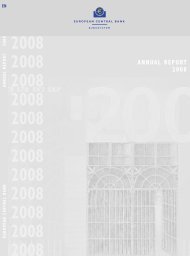Reserve Bank of Australia Annual Report 2011
Reserve Bank of Australia Annual Report 2011
Reserve Bank of Australia Annual Report 2011
You also want an ePaper? Increase the reach of your titles
YUMPU automatically turns print PDFs into web optimized ePapers that Google loves.
During 2010/11, the cash rate traded at target on all business days. The <strong>Reserve</strong> <strong>Bank</strong>’s standing facility for<br />
overnight repos was accessed only twice, continuing a trend toward less usage over time.<br />
Usage <strong>of</strong> Overnight Standing Facility<br />
Number <strong>of</strong> times used<br />
Value ($m)<br />
2006/07 24 3 589<br />
2007/08 18 4 220<br />
2008/09 15 3 257<br />
2009/10 5 1 035<br />
2010/11 2 363<br />
Source: RBA<br />
Payment flows each day between ES account holders and the <strong>Reserve</strong> <strong>Bank</strong>’s customers (principally, the<br />
<strong>Australia</strong>n Government) can alter the aggregate level <strong>of</strong> ES balances. As a result, the <strong>Bank</strong> needs to transact<br />
in the market on most days in order to <strong>of</strong>fset the impact <strong>of</strong> its customer flows. For further details, see<br />
‘Domestic Market Operations and Liquidity Forecasting’ in the <strong>Bank</strong>’s December 2010 Bulletin. In the past<br />
year, unexpected liquidity flows saw the <strong>Bank</strong> conduct a second round <strong>of</strong> dealing on two occasions, the<br />
same as in the previous year.<br />
Over the past year, aggregate ES balances averaged a little over $1¼ billion, with the <strong>Reserve</strong> <strong>Bank</strong> facilitating<br />
temporarily higher levels around key balancing dates in order to keep the cash market operating smoothly.<br />
While this is less than the level <strong>of</strong> balances held during the financial crisis, it is higher than the levels recorded<br />
before the crisis, reflecting a desire on the part <strong>of</strong> some ADIs to hold higher precautionary balances.<br />
Most <strong>of</strong> the <strong>Reserve</strong> <strong>Bank</strong>’s transactions within the domestic market are contracted as repos. Under a repo,<br />
one party agrees to sell a security to another with an agreement to repurchase the security at a future date at<br />
a pre-agreed price. In its market operations, the <strong>Reserve</strong> <strong>Bank</strong> is willing to purchase both government-related<br />
debt securities (‘general collateral’) and private debt securities under repo. To guard against a fall in the value <strong>of</strong><br />
the security in the event that the counterpart to the transaction may not be able to repurchase their security at<br />
the agreed time, the <strong>Bank</strong> requires the value <strong>of</strong> collateral to be higher than the cash lent by some percentage<br />
<strong>of</strong> the security’s initial price. These percentages range from 2 to 10 per cent, increasing with the risk pr<strong>of</strong>ile <strong>of</strong><br />
the security.<br />
Over the past year, the value <strong>of</strong> securities held<br />
under repo has ranged between $20 billion and<br />
$35 billion as the balance sheet has fluctuated with<br />
the movements in Government deposits discussed<br />
earlier. In contrast to recent years, governmentrelated<br />
securities now account for the bulk <strong>of</strong><br />
securities held under repo. During the period <strong>of</strong><br />
financial market turbulence in 2008 and 2009,<br />
many ADIs created securities backed by residential<br />
mortgages they were holding on their balance<br />
sheets and sold them to the <strong>Bank</strong> under repurchase<br />
agreement. Although highly rated residential<br />
mortgage-backed securities (RMBS) remain eligible<br />
for the <strong>Bank</strong>’s market operations, the <strong>Bank</strong> expects<br />
ADIs to present related-party mortgages only in<br />
extraordinary circumstances.<br />
$b<br />
16<br />
12<br />
8<br />
4<br />
ES balances<br />
(LHS)<br />
Balances Held at RBA<br />
Cash rate<br />
(RHS)<br />
0<br />
l l l l<br />
2007 2008 2009 2010 <strong>2011</strong><br />
Source: RBA<br />
%<br />
8<br />
6<br />
4<br />
2<br />
0<br />
ANNUAL REPORT <strong>2011</strong> | Operations in Financial Markets<br />
17





![KNOW YOUR NEW GIBRALTAR BANKNOTES - [Home] bThe/b](https://img.yumpu.com/50890985/1/184x260/know-your-new-gibraltar-banknotes-home-bthe-b.jpg?quality=85)
![PAPUA NEW GUINEA - [Home] - Polymer Bank Notes of the World](https://img.yumpu.com/49758743/1/190x143/papua-new-guinea-home-polymer-bank-notes-of-the-world.jpg?quality=85)










